#“Certainty!....”
Text
something something glammike thing where annoying ghost hunters come to the pizzaplex and ask questions about william and the MCI and the hauntings and some influencers rent the place from time to time for that sweet sweet fazclout and this really peeves glamfreddy because Michael knows firsthand that this isn't something you really want to poke about
(maybe for the fun of it, and CC's personal suggestion, Glamfreddy makes a snide comment about biting the ghost hunters lol)(they probably know what it means lmao)
#alright#huh? yeah-(someones gotta fix that robot) anyways-#“Did you know it was actually in the safe room where the original missing children incident victims where murdered? They were stuffed in-”#fnaf#michael afton#five nights at freddy’s#glammike#glamrock freddy#I have this thing where the influencers are trying to do a video and glamfreddy was temporarily reprogramed to move stuff around for them#But Michael just really isnt having it so in the character of glamfreddy he just starts spewing cryptic shiz because haha funny#just stuff that the in-character-preformer robot REALLY wouldn't know lmao#“Freddy can you move that box”#“Certainty!....”#You know#O-KAY! THANK YOU#Idk why I put all of this in the tags lmao itd be much easier to just....put it in the post buuuuuut im too lazy teehee#anyways maybe when some especially annoying ghost hunters/influencers come Michael calls in reinforcements (lizzy Charlie and CC)#you know#to give the lads some spooks#Listen my mans is so tired and he has to be forced to be still and play the same songs since that day let him have some shenaniganry#no guys its okay he secretly likes performing trust#sigh im mischaracterizing my pookie so bad im so sorry#Anyways rememeber to Glive Glaugh Glammike chat 🙏🙏🙏🙏
27 notes
·
View notes
Text
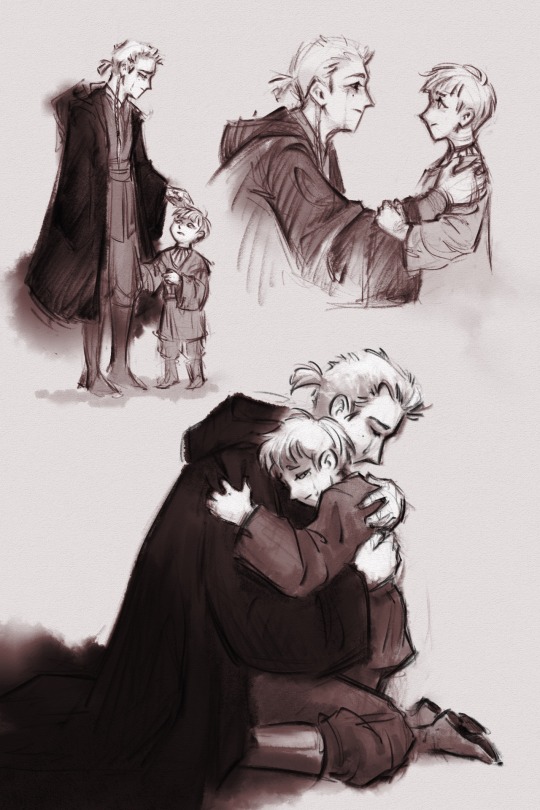
Lost boys
#mayhem art#star wars#anakin skywalker#obi wan kenobi#anakin skywalker fanart#obi wan kenobi fanart#star wars art#this one was sitting in my drafts for about a month. idk why I was holding onto it -cries- anyway#this is shortly after Qui-Gon's death. Both of their lives just got flipped upside down. Anakin is traumatized by having to leave#his mother behind‚ then his Master's sudden death‚ and he's left with no certainty in his future.#Obi-Wan just witnessed his Master die‚ helplessly‚ then having to take care of this little human in his Master's stead‚ meanwhile feeling#wholly inadequate to be so suddenly knighted let alone immediately becoming a Master and taking responsibility for another being.#Both of them losing the constants in their lives. left uprooted. the only anchoring point being each other.#I imagine Obi-Wan wouldn't reach out to Anakin first‚ but if Anakin expressed compassion with him‚ grief‚ and his need to feel secure‚#Obi-Wan wouldn't turn him away#this was just my excuse to give them a proper soothing hug in their time of mourning
1K notes
·
View notes
Text
fumbling a man with long hair has felled even the mightiest warriors
#🐉#i am NOT speaking from personal experience but if i ever do fuck it up so bad with a man with long hair#i know with 100% certainty that ill be driven to clawing writhing griefstricken madness
3K notes
·
View notes
Text

(per Joe's stream this morning, in which Quinn exclaimed "That Juppet is DEFINITELY divorced," my friend @the-joju-experience made this meme and requested I share)
#joe hills#hermitcraft 10#s10#juppet#quinn hills#Quinn saying that VERY nearly made me spit out my coffee. the certainty in her voice sdjkgh#also everyone wish good luck to Joju! he cannot log in to post memes as he is tragically ensconced in thesis writing
658 notes
·
View notes
Text
I can't believe the opening of the wire is julian being like 'hm. garak doesn't seem elated to hang out with me. something's obviously seriously wrong'. and he's right
#dax being like 'maybe garak just doesn't like going to see the doctor'#and julian IMMEDIATELY with complete certainty going 'no. that's definitely not it' fdsakjdfhsa#garashir#star trek#star trek ds9#ds9#julian bashir
621 notes
·
View notes
Text
The fact that I can wholeheartedly enjoy ofmd and good omens and appreciate the angst because I KNOW there will be a happy ending.
See, I’ve never had that. None of us queer folks have ever had that.
#it’s boggling my mind#how a thing that is so simple is so groundbreaking#do you realise how fucking starved for content we have been#AND ON TOP OF THAT WITH MIDDLE AGED COUPLES!!!!!#maybe we can live past thirty and be happy#oh no I made myself cry#also I know that technically we don’t have the certainty that ofmd will have a happy ending but like#it’s a bunch of queer people put into the same room if the flag actually ends up meaning death again I will burn something#our flag means death#ofmd#good omens#good omens 2
2K notes
·
View notes
Text
"If you could have any superpower, what w-"
Shapeshifting. Shapeshifting shapeshifting shapeshifting. I'm a transgender therian, what the fuck did you think I would pick.
#andiv3r rambles#transgender#therian#therianthropy#transmasc#cladotherian#feline cladotherian#<- prev 2 tags may not accurately represent me#but i'm still figurin stuff out#cat therian#trans#trans guy#coyote therian#coyote theriotype#feline therian#feline theriotype#oh btw! i'm a therian :')#y e a h#finally comfortable enough to say with certainty#so if you don't support#get the fuck off my blog#thanks <3#andiv3r howls
807 notes
·
View notes
Note
Just wanted to say I really enjoy following you and seeing posts on my feed of your oc's! Here's a quick sketch of Machete I drew as I find his design to be amazing
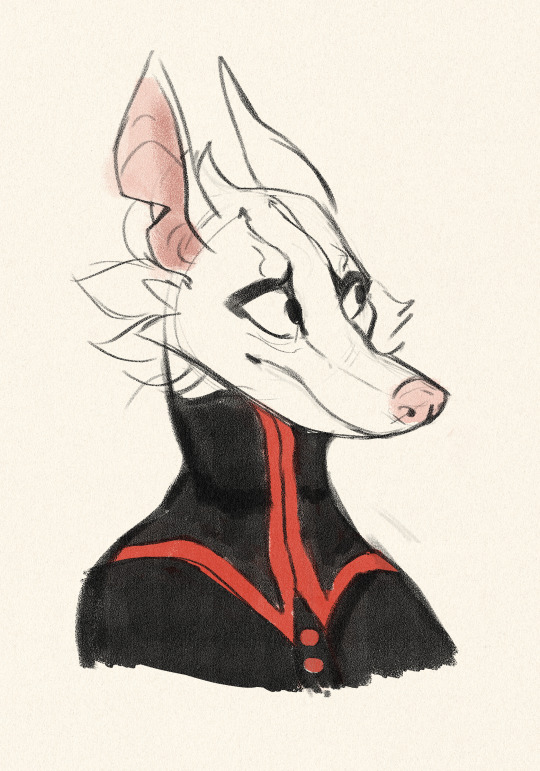
.
#that's so terribly sweet ;_;#thank you for your kind words#I really like your lineart your shapes have such wonderful flow and effortless certainly to them#and I've mentioned how much I love texturous brushwork#really pleasing to the eyes#he looks so charming and personable in your style#maybe this is a weirdly specific thing to say but something about this makes me think of character concept art for an animated film#thank you!#gift art#artnwill#own characters#Machete#*certainty
503 notes
·
View notes
Text

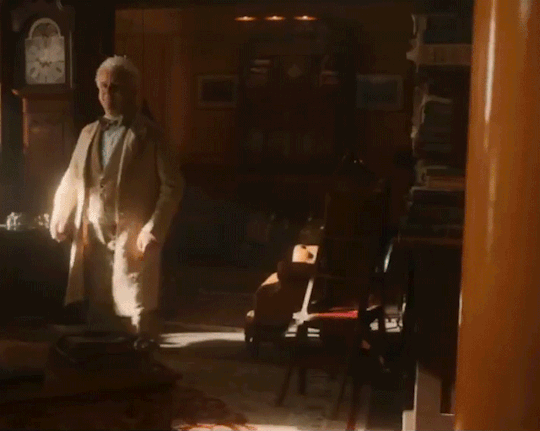
I think I—
GOD. MY HEART.
He nearly says it. He nearly says ‘I think I ought to stay.’ But Metatron is walking off, very deliberately walking off without giving Aziraphale any time to respond.
GOD.
#episode 6#Aziraphale is looking in the direction where Crowley went for almost all of this scene#he is almost ready to drop everything#but the expectation#Metatron's projected certainty#the millenia-deep urge to obey#not to disappoint#to be good enough#my GOD#AZIRAPHALE NO#good omens season 2#good omens#good omens spoilers#I am sorry for the quality of these gifs but LOOK AT HIM#good omens season 2 spoilers
2K notes
·
View notes
Text
Demon-haunted computers are back, baby
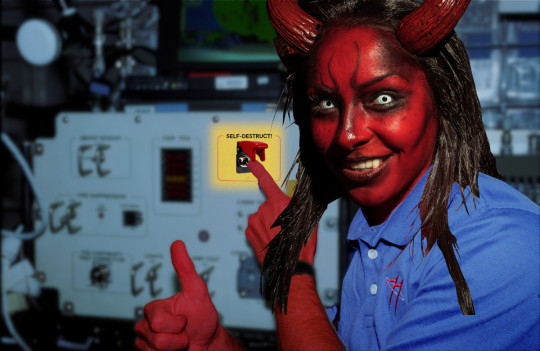
Catch me in Miami! I'll be at Books and Books in Coral Gables on Jan 22 at 8PM.

As a science fiction writer, I am professionally irritated by a lot of sf movies. Not only do those writers get paid a lot more than I do, they insist on including things like "self-destruct" buttons on the bridges of their starships.
Look, I get it. When the evil empire is closing in on your flagship with its secret transdimensional technology, it's important that you keep those secrets out of the emperor's hand. An irrevocable self-destruct switch there on the bridge gets the job done! (It has to be irrevocable, otherwise the baddies'll just swarm the bridge and toggle it off).
But c'mon. If there's a facility built into your spaceship that causes it to explode no matter what the people on the bridge do, that is also a pretty big security risk! What if the bad guy figures out how to hijack the measure that – by design – the people who depend on the spaceship as a matter of life and death can't detect or override?
I mean, sure, you can try to simplify that self-destruct system to make it easier to audit and assure yourself that it doesn't have any bugs in it, but remember Schneier's Law: anyone can design a security system that works so well that they themselves can't think of a flaw in it. That doesn't mean you've made a security system that works – only that you've made a security system that works on people stupider than you.
I know it's weird to be worried about realism in movies that pretend we will ever find a practical means to visit other star systems and shuttle back and forth between them (which we are very, very unlikely to do):
https://pluralistic.net/2024/01/09/astrobezzle/#send-robots-instead
But this kind of foolishness galls me. It galls me even more when it happens in the real world of technology design, which is why I've spent the past quarter-century being very cross about Digital Rights Management in general, and trusted computing in particular.
It all starts in 2002, when a team from Microsoft visited our offices at EFF to tell us about this new thing they'd dreamed up called "trusted computing":
https://pluralistic.net/2020/12/05/trusting-trust/#thompsons-devil
The big idea was to stick a second computer inside your computer, a very secure little co-processor, that you couldn't access directly, let alone reprogram or interfere with. As far as this "trusted platform module" was concerned, you were the enemy. The "trust" in trusted computing was about other people being able to trust your computer, even if they didn't trust you.
So that little TPM would do all kinds of cute tricks. It could observe and produce a cryptographically signed manifest of the entire boot-chain of your computer, which was meant to be an unforgeable certificate attesting to which kind of computer you were running and what software you were running on it. That meant that programs on other computers could decide whether to talk to your computer based on whether they agreed with your choices about which code to run.
This process, called "remote attestation," is generally billed as a way to identify and block computers that have been compromised by malware, or to identify gamers who are running cheats and refuse to play with them. But inevitably it turns into a way to refuse service to computers that have privacy blockers turned on, or are running stream-ripping software, or whose owners are blocking ads:
https://pluralistic.net/2023/08/02/self-incrimination/#wei-bai-bai
After all, a system that treats the device's owner as an adversary is a natural ally for the owner's other, human adversaries. The rubric for treating the owner as an adversary focuses on the way that users can be fooled by bad people with bad programs. If your computer gets taken over by malicious software, that malware might intercept queries from your antivirus program and send it false data that lulls it into thinking your computer is fine, even as your private data is being plundered and your system is being used to launch malware attacks on others.
These separate, non-user-accessible, non-updateable secure systems serve a nubs of certainty, a remote fortress that observes and faithfully reports on the interior workings of your computer. This separate system can't be user-modifiable or field-updateable, because then malicious software could impersonate the user and disable the security chip.
It's true that compromised computers are a real and terrifying problem. Your computer is privy to your most intimate secrets and an attacker who can turn it against you can harm you in untold ways. But the widespread redesign of out computers to treat us as their enemies gives rise to a range of completely predictable and – I would argue – even worse harms. Building computers that treat their owners as untrusted parties is a system that works well, but fails badly.
First of all, there are the ways that trusted computing is designed to hurt you. The most reliable way to enshittify something is to supply it over a computer that runs programs you can't alter, and that rats you out to third parties if you run counter-programs that disenshittify the service you're using. That's how we get inkjet printers that refuse to use perfectly good third-party ink and cars that refuse to accept perfectly good engine repairs if they are performed by third-party mechanics:
https://pluralistic.net/2023/07/24/rent-to-pwn/#kitt-is-a-demon
It's how we get cursed devices and appliances, from the juicer that won't squeeze third-party juice to the insulin pump that won't connect to a third-party continuous glucose monitor:
https://arstechnica.com/gaming/2020/01/unauthorized-bread-a-near-future-tale-of-refugees-and-sinister-iot-appliances/
But trusted computing doesn't just create an opaque veil between your computer and the programs you use to inspect and control it. Trusted computing creates a no-go zone where programs can change their behavior based on whether they think they're being observed.
The most prominent example of this is Dieselgate, where auto manufacturers murdered hundreds of people by gimmicking their cars to emit illegal amount of NOX. Key to Dieselgate was a program that sought to determine whether it was being observed by regulators (it checked for the telltale signs of the standard test-suite) and changed its behavior to color within the lines.
Software that is seeking to harm the owner of the device that's running it must be able to detect when it is being run inside a simulation, a test-suite, a virtual machine, or any other hallucinatory virtual world. Just as Descartes couldn't know whether anything was real until he assured himself that he could trust his senses, malware is always questing to discover whether it is running in the real universe, or in a simulation created by a wicked god:
https://pluralistic.net/2022/07/28/descartes-was-an-optimist/#uh-oh
That's why mobile malware uses clever gambits like periodically checking for readings from your device's accelerometer, on the theory that a virtual mobile phone running on a security researcher's test bench won't have the fidelity to generate plausible jiggles to match the real data that comes from a phone in your pocket:
https://arstechnica.com/information-technology/2019/01/google-play-malware-used-phones-motion-sensors-to-conceal-itself/
Sometimes this backfires in absolutely delightful ways. When the Wannacry ransomware was holding the world hostage, the security researcher Marcus Hutchins noticed that its code made reference to a very weird website: iuqerfsodp9ifjaposdfjhgosurijfaewrwergwea.com. Hutchins stood up a website at that address and every Wannacry-infection in the world went instantly dormant:
https://pluralistic.net/2020/07/10/flintstone-delano-roosevelt/#the-matrix
It turns out that Wannacry's authors were using that ferkakte URL the same way that mobile malware authors were using accelerometer readings – to fulfill Descartes' imperative to distinguish the Matrix from reality. The malware authors knew that security researchers often ran malicious code inside sandboxes that answered every network query with fake data in hopes of eliciting responses that could be analyzed for weaknesses. So the Wannacry worm would periodically poll this nonexistent website and, if it got an answer, it would assume that it was being monitored by a security researcher and it would retreat to an encrypted blob, ceasing to operate lest it give intelligence to the enemy. When Hutchins put a webserver up at iuqerfsodp9ifjaposdfjhgosurijfaewrwergwea.com, every Wannacry instance in the world was instantly convinced that it was running on an enemy's simulator and withdrew into sulky hibernation.
The arms race to distinguish simulation from reality is critical and the stakes only get higher by the day. Malware abounds, even as our devices grow more intimately woven through our lives. We put our bodies into computers – cars, buildings – and computers inside our bodies. We absolutely want our computers to be able to faithfully convey what's going on inside them.
But we keep running as hard as we can in the opposite direction, leaning harder into secure computing models built on subsystems in our computers that treat us as the threat. Take UEFI, the ubiquitous security system that observes your computer's boot process, halting it if it sees something it doesn't approve of. On the one hand, this has made installing GNU/Linux and other alternative OSes vastly harder across a wide variety of devices. This means that when a vendor end-of-lifes a gadget, no one can make an alternative OS for it, so off the landfill it goes.
It doesn't help that UEFI – and other trusted computing modules – are covered by Section 1201 of the Digital Millennium Copyright Act (DMCA), which makes it a felony to publish information that can bypass or weaken the system. The threat of a five-year prison sentence and a $500,000 fine means that UEFI and other trusted computing systems are understudied, leaving them festering with longstanding bugs:
https://pluralistic.net/2020/09/09/free-sample/#que-viva
Here's where it gets really bad. If an attacker can get inside UEFI, they can run malicious software that – by design – no program running on our computers can detect or block. That badware is running in "Ring -1" – a zone of privilege that overrides the operating system itself.
Here's the bad news: UEFI malware has already been detected in the wild:
https://securelist.com/cosmicstrand-uefi-firmware-rootkit/106973/
And here's the worst news: researchers have just identified another exploitable UEFI bug, dubbed Pixiefail:
https://blog.quarkslab.com/pixiefail-nine-vulnerabilities-in-tianocores-edk-ii-ipv6-network-stack.html
Writing in Ars Technica, Dan Goodin breaks down Pixiefail, describing how anyone on the same LAN as a vulnerable computer can infect its firmware:
https://arstechnica.com/security/2024/01/new-uefi-vulnerabilities-send-firmware-devs-across-an-entire-ecosystem-scrambling/
That vulnerability extends to computers in a data-center where the attacker has a cloud computing instance. PXE – the system that Pixiefail attacks – isn't widely used in home or office environments, but it's very common in data-centers.
Again, once a computer is exploited with Pixiefail, software running on that computer can't detect or delete the Pixiefail code. When the compromised computer is queried by the operating system, Pixiefail undetectably lies to the OS. "Hey, OS, does this drive have a file called 'pixiefail?'" "Nope." "Hey, OS, are you running a process called 'pixiefail?'" "Nope."
This is a self-destruct switch that's been compromised by the enemy, and which no one on the bridge can de-activate – by design. It's not the first time this has happened, and it won't be the last.
There are models for helping your computer bust out of the Matrix. Back in 2016, Edward Snowden and bunnie Huang prototyped and published source code and schematics for an "introspection engine":
https://assets.pubpub.org/aacpjrja/AgainstTheLaw-CounteringLawfulAbusesofDigitalSurveillance.pdf
This is a single-board computer that lives in an ultraslim shim that you slide between your iPhone's mainboard and its case, leaving a ribbon cable poking out of the SIM slot. This connects to a case that has its own OLED display. The board has leads that physically contact each of the network interfaces on the phone, conveying any data they transit to the screen so that you can observe the data your phone is sending without having to trust your phone.
(I liked this gadget so much that I included it as a major plot point in my 2020 novel Attack Surface, the third book in the Little Brother series):
https://craphound.com/attacksurface/
We don't have to cede control over our devices in order to secure them. Indeed, we can't ever secure them unless we can control them. Self-destruct switches don't belong on the bridge of your spaceship, and trusted computing modules don't belong in your devices.
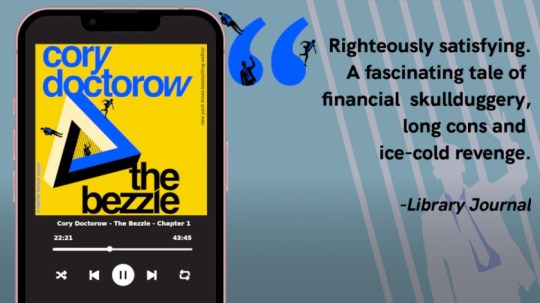
I'm Kickstarting the audiobook for The Bezzle, the sequel to Red Team Blues, narrated by @wilwheaton! You can pre-order the audiobook and ebook, DRM free, as well as the hardcover, signed or unsigned. There's also bundles with Red Team Blues in ebook, audio or paperback.

If you'd like an essay-formatted version of this post to read or share, here's a link to it on pluralistic.net, my surveillance-free, ad-free, tracker-free blog:
https://pluralistic.net/2024/01/17/descartes-delenda-est/#self-destruct-sequence-initiated

Image:
Mike (modified)
https://www.flickr.com/photos/stillwellmike/15676883261/
CC BY-SA 2.0
https://creativecommons.org/licenses/by-sa/2.0/
#pluralistic#uefi#owner override#user override#jailbreaking#dmca 1201#schneiers law#descartes#nub of certainty#self-destruct button#trusted computing#secure enclaves#drm#ngscb#next generation secure computing base#palladium#pixiefail#infosec
577 notes
·
View notes
Text

Friend and I were pondering the curious specificities of the Permitted Aristo
#lord peter wimsey#creeping yellowly into your nightclubs#where you sneakily drink skimmed milk#so lovable so weird#pondering upon the curious predictions of the 1930/#the cheerful conviction of a socialist revolution and#the certainty that social order would reverse#it’s also interesting that Peter being born in the 1890s#is picturing himself in the 1980s or 1990s here#communist British scallywags and punks sneaking off to drink raw milk#go off girlies!!!
415 notes
·
View notes
Note
was thinking about this earlier but the dynamic of cannibalism being associated with high society and the culinary elite (hannibal comes to mind specifically) while also simultaneously being associated with the socially isolated and economically impoverished (as in texas chainsaw massacre) is so interesting to me i want to read 10 million books on why it happens so much in media....
i can only speak from a place of personal opinion and general knowledge, because i haven't read that many papers or in-depth studies on cannibalism, but i think it often comes down to an interesection between the themes of the story you're telling and class structures and divisions. cannibalism is a compelling form of narrative symbolism because it's undeniably impactful and hard to ignore. when portrayed as a practice associated with the culinary and social upper class, it might be used as a critique of the rich and powerful and their lack of ethics and willingness to consume and destroy others for their own self-interest by showing them literally preying on and consuming their victims, or a horror story/cautionary tale about how having everything can lead you to never be satisfied and turn to increasingly extreme measures to feel like life is worth living, or a dark fantasy of indulgence and excess. when associated with the poor, marginalized and isolated, it's often based in bigotry and harmful stereotypes of the "primitive" "inhuman" "savage" "other", however it might also function as a revenge fantasy where the most oppressed and exploited members of society turn on their oppressors and take "eating the rich" to its most literal extreme, exposing the fragility of class divisions and pointing out that those in positions of social and economic power are hardly the mythic titans their propaganda tries to make them out to be, but ultimately just as mortal and made of flesh and blood as any other human being, and not immune to being dragged down from their position at the top of the food chain and torn to pieces by the crowd (as well as reminding the audience of their own fragile mortality and precarious position in the social order, and the humanity we all share in common - however cannibalism often divides the perpetrators from both their victims and the audience, so this is rarer than the other interpretations mentioned).
cannibalism and power often go hand in hand. cannibalism has historically been used as both a means of displaying your power over defeated opponents and delivering a final, humiliating blow to their image by consuming their flesh, and a means of othering and dehumanizing your opponent by portraying them as the cannibalistic monster.
both the very rich and very poor also tend to be perceived as more distant from the people who make and consume these stories, making them easier to project fiction onto and transform into symbols and narrative devices (or, in the worst cases, dehumanize) than those who occupy the same social spheres as the creator. they can be held at an arm's length without discomfort and, depending on the target audience, may be a source of fascination due to the differences in their lived experiences. it adds to the fantasy, and makes any inaccuracies, exaggerations and fabrications feel more plausible because the majority of the audience probably don't have any personal experiences of being in those positions to draw on.
#cannibalism#classism#like this is literally just my interpretation based on my knowledge of media studies literary analysis and sociology#i cant say with any certainty whether its a True and Accurate assessment
2K notes
·
View notes
Text

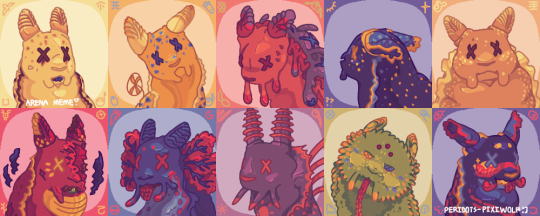
[Start ID. A redraw of the official icons of the ten named slugcats from Rain World, arranged in two rows: Survivor, Monk, Hunter, Nightcat, and Gourmand in the first, Artificer, Rivulet, Spearmaster, Saint and Enot/Inv in the second. Each is drawn in roughly the same pose as in the original art and fitted with speculative interpretations of their biology, and the second image is a “dead” version of this. For example, all ten have slug-like rhinophores in place of ears, cuttlefish-like colorful eyes with strangely-shaped pupils, cephalopod-like beak "teeth", expressive barbels or oral tentacles at the corners of mouths, spiny radulas, and the frilly mantle fringes of sea slugs, though otherwise their faces are squishy, simple and mammalian-shaped.
Cream-colored Survivor and yellow Monk both share triangular, bicolored spots matching their eyes (which are tan and brown, and two shades of blue, respectively), small, bumpy fringes, and relatively neutral looks on their faces. Defensive-looking Hunter is mostly a dull orange-pink, though their blobby fringe is a more violent red and their back is purple and marred with lumps. Nightcat is navy blue and flecked with dots of yellow and teal, their rolled rhinophores are a lighter blue, and their shading fractures into stars in some places. Gourmand is almost uniformly tan, their wide, very ruffly white mantle fringe bordered by a spray of white spots, and their beak sticks out from either corner of their smile. Primarily red Artificer, snarling, has yellow markings of multiple sorts, a prominent yellow dewlap and their characteristic dark scar taking out a chunk of its face. Rivulet is a darker blue than usual, with long barbels, red gills and rings, countershading, and a cheerful expression, sticking out their radula. Spearmaster is purple with orange accents, eyes and spots, a large fringe and spines down their back. Saint’s green caryophyllidia are marked by small, yellow diamonds, and their long, thin radula extends far below them. Enot is decorated with mottled red stripes, blue patches, yellow stars, and an uneven and almost cartoonish imitation of blush, though generally the same deep blue as Nightcat, a passive or almost slightly smug look on their face and their rolled rhinophores out to either side.
In the second image, nine of the slugcats’ eyes are crossed out, indicating that these are death icons. They look fairly the same, with mostly expression differences. Survivor is caught in the beginning of a threat display, a karma flower sprouts from Monk’s side, Hunter is burdened with overgrowing, purple and blue rot, Nightcat’s rhinophores are pinned back, and Gourmand looks mildly disheartened. For the final row, Artificer bites its radula between small plumes of smoke, Rivulet drops their expression, Spearmaster looks very startled, Saint looks almost entirely the same besides half-open eyes and their markings greater in number, and Enot grins confusedly. End ID]
If you'll excuse the unusually lengthy ID: the arena meme introduced by @pansear-doodles at long last after a nearly year-long wip status (or, rather, finished a month ago today to honor my own first time playing it!)
Design notes and shout-outs under cut! :]
The following people are some of those who’ve inspired my designs most since I started this eight months ago (or just inspired me to get a little weirder with slugcat biology), among many others for sure, and I thank them for it–but this is simply to bring attention to artists I find cool, and in no way an obligation to interact or anything :]
> @saturncoyote , @carpsoup , @charseraph , @gallusgalluss , @bitsbug , @dopscratch , and @0hmanit (and a special mention to dddeerbo and hunterlonglegs, who’ve since deactivated)!
Survivor: Surprisingly the hardest to pin down the colors for, since nothing with its sibling's palette seemed to match up right (I did have to add in a little blue somewhere for Monk, the beginning of making it clear how much I’m simply going based off of vibes for the colors of scug innards). I consider them, Monk and Gourmand to be part of the same gene pool of slugcats, and even possibly the same colony even if the latter isn't really related, so took a bit of Gourmand's coloring and fit them in with their inspiration: Goniobranchus verrieri. They serve as a bit of an introduction to my ideas of scug traits (i find it really fun how many people have thought to add so many silly sluglike fixtures of biology completely independent of me, buuut here I’m mostly talking about species variation), and like in-game they’re pretty average! They, Monk and Hunter have a couple scars sourced from a piece of Joar's concept art that I'm failing to find, those across the bridge of the nose, under the eyes, and across the rhinophores, respectively, and my Survivor interpretation features many on the back of the neck, as a result of survived lizard bites.
Monk: Their coloring is primarily based off the fact that I associate them with blue fruits, honestly, a bit because I was compelled to establish a familiarity with Rivulet, and lastly inspired by the spots of Goniobranchus kuniei (and geminus, less important to me as one of my characters is a kuniei instead, but more fitting). Between the yellow + blue and the circular marking in the center of their face, they’re meant to bear a little resemblance to an iterator that shares similarities with the characterization I’ve given them, and similar coding of her sibling can be seen on Survivor’s markings around the eyes. As both a “default” slugcat and one whose campaign I haven’t played, though, I can’t say I have much more to point out about em.
Hunter: The whole rot thing made for a really fun time drawing them, and while the color change on their back is a result of this, it’s also an excuse to relate them to Babakina festiva, arguably my favorite sea slug (mostly for sentimental purposes). And to Spearmaster, a fellow messenger slugcat, and it serves as a gradient between Hunter’s pink and the “traditional” color of Rot seen in the DLLs. Aside from their affliction, they’d actually be the plainest in terms of design, as they don’t have any patterns or quirks of body type, just the red + purple and strange lumps + possible malnutrition. I can’t remember if NSH had created them in particular or just...caught + released or something, but it probably wouldn’t be strange for a lab-grown slugcat to be simple like that.
Gourmand: Like the two above, they’re rather plain in terms of coloring and adaptation, and like the two above, I find that fun. I decided it would be nice to avert the “all slugcats being of the same body type, and Gourmand’s out of place as the exception” thing by just...adding more fat to all of them, really. I did want to emphasize their sheer bulk even so, both fat and muscular (not like I couldn’t have still gone further with it, of course, but slugcat anatomy can be a little obfuscating sometimes, and they were intended to look rather plush considering personal size headcanons and therefore the lack of proper gravity), and the thick and flounced mantle looked like a good addition, as per their sea slug Glossodoris hikuerensis. Unlike Survivor and Monk, I didn’t attempt to hold their resemblance to any particular other character (which means a little less to balance out the “default gene pool” thing), so those are all the design notes I have for em.
Artificer: The second slugcat I’ve ever played, or finished the campaign of, my favorite for at least a long time, and the first thing I did was give them yellow accents, the shape of which have troubled me slightly (not quite like the spots or stripes of the others). They’re both a little more appealing and more explosive-looking to me, and considering how early on I played Arti, actually present in some of my older art. It does give them a little resemblance to Saint (completely intentional, two slugcats with strange relations to karma), as well as the fact that its radula is green for familiarity with one of its children (at some point it was going to have all-green markings, even!). I’m generous with their scars, partly because it was fun to overemphasize the one on their face and partly because it does seem like a reckless slugcat, on top of the dangers of its explosive abilities–I’ll probably just keep adding more forever. Mostly-red sea slugs aren’t too common, but Hexabranchus sanguineus works for sure. The ridged, yellow dewlap can expand for combustion purposes, or something along those lines. Arti’s where I began experimenting with a lot of the mildly-offkilter features seen in my interpretation of slugcats, as they’ve once again been a favorite from the start.
Rivulet: I've obviously given other slugcats spots, deeply enjoy the bubbly-soda markings of other peoples' slugcats, and thought seal riv would be cute. Despite not too closely resembling it, they've been government-assigned Hypselodoris bennetti, for color reasons and for a couple sentimental ones. Originally, the colors of every scug were meant to match up with the custom colors I gave them at the beginning of their campaigns, (though Arti, Gourm and Spearmy are the only three who actually apply here, since I've only played through half the slugcats: I gave arti the yellow as mentioned above, gourm brown eyes and spearmy light pink spears, furthered by the outskirts pearl accompanying me and that palette all the way to moon. Tolerance training for eternity in hell cause I already knew about the maroon pearl quest). I initially gave them the colors of the bi flag for fun... but with the limited palette of this image, I was left without pink for a while and decided to see how they'd look in red. I then realized how they now wonderfully matched Moon, and besides, red's a sort of camouflage in deep water! As a side-note, the difference between their eyes and those of others always bothered me a little for anatomical purposes, and the cephalopod eyes were probably influenced by this!
Spearmaster: Inspired as much as possible by @notyourfunnyman ’s wonderful spearmy: designed in a way that helps it fit in with scavengers, at least between the long sensory tentacles, big ruff, back spines and slightly thin/distended anatomy, a form of defensive mimicry. I always had annulate rhinophores in mind, for a little diversity sure, but mostly because the shape reminds me of radio antennae and communication towers (seems fitting for the comms array and being a messenger slugcat)! I started searching for a real-life slug to give them just by looking up their rhinophore shape...and was met immediately and coincidentally with annulate-topped nudibranchs that fit them more perfectly than I could've imagined: Flabellina and surrounding clades, I think Paraflabellina ischitana works very nicely. The orange was completely unplanned, but there wasn’t a place for light pink among the other slugcats’ palettes, and importantly it likens them to both Hunter and Seven Red Suns a little more.
Saint: I am very much a non-furred slugcat enjoyer, with respect to those who aren’t, so figuring out the only visibly furred slugcat was an interesting challenge. I’ve decided that they likely have other, milder adaptations for help in the cold, mainly just more efficient fat storage, and what looks vaguely like fur is instead a bunch of tubercles (called caryophillia, for the second reminder out of three). Their inspiration doesn’t have these, however, Miamira sinuata’s numerous yellow and blue spots (not to mention...whatever’s going on with that shape) and general effect of being the only really green nudibranch I could find were probably perfect for a strange green echo. Not pictured, but their beak-teeth are tiny and flat to make a surface for grinding soft food against with the lack of a functioning radula, which is tipped with a specialized spiny “grapple-hook” for better traction/grip (not to mention the numerous little teeth running down the whole thing).
(Best part of hiding this under a readmore means edits will be seen by all reblogs, I'm mostly sure, because I completely forgot to mention! The spots on their forehead are simple eyes. Their camera eyes appear closed in-game, I like to believe their complex eyesight is rather poor anyways or otherwise reason that they aren't seeing out of those, and while this was far from her REASON for attunement with the world, it does help compensate for mainly viewing it through a canvas of simple light and dark. This, and the fact that their swapped-out "fur" is not only to commit to a lack of hairs but contributes to sensory input!)
Nightcat/Enot: I guess you could say I found the “these two are technically the same person” compelling. (E.g. similar colors, both very strange and enigmatic, and Enot/Inv/Sofanthiel’s remark during the dating sim about getting removed from Arena Mode.) I doubt they’re the only two slugcats in their body, considering humans with DID tend to have more than a few (and I find it very funny that a slugcat bearing resemblance to Nightcat appears in Gourmand’s ending. They’re allowed in the colony and Enot isn’t </3), and I have to credit @faelingdraws ’s art for being what convinced me on it! Their design inspirations come down to trying to balance a few different ideas: making the patterns and palettes of both look oddly similar (special mention to the stars, since those are fun to draw), basing them off of Felimare sechurana and juliae respectively, using blocks of color with the same placement as in Enot’s official art, and specifically making Enot look...biologically reasonable and imperfect, whilst also clearly trying to imitate human displays of emotion (what with...the eyes and blush on that one piece of official art).
Lastly, here’s just a lineup with notes on body shape and size. Most of the nicknames (existing to give a little more space, that’s all) are obvious, and while I can’t remember why I shortened Nightcat to Nox, it is in honor of my friend by the same nickname :]

#survivor rain world#monk rain world#hunter rain world#nightcat rain world#gourmand rain world#artificer rain world#rivulet rain world#spearmaster rain world#saint rain world#enot rain world#slugcat rain world#rain world#peridots-art#< feels like too long since that last tag's been used. i can say with certainty that the majority of the reason i haven't been just as#active here (not to mention not drawing as often since that's relevant) is just due to my life getting busier with a new school year but i#do miss putting my stuff here! and would like to reblog more on top of that.... so forgive not remembering exactly how to tag everything#(and how to write everything up there but to be fair it's not like long textposts were a staple of mine. i mostly just rambled and it was#fun hehehe.....some of those notes (parts of riv/spears mostly) were written around the beginning of the drawing itself)#OH i messed something up with the drafting and really did not mean to post it while tags were in progress! but regardless. i would've liked#to post it tomorrow to mirror how i was going to post it on JAN 29 a month ago......but it's not like i'm unhappy with this outcome :]#to sum it up really though it's been strange working on this for so long.....unfortunate to not get a chance to let it be seen and keep#experimenting with odd biology much earlier but i'm just glad it's out now cause i am proud of these!! it's been a lot of fun and slugcats#are still my go-to doodles :] if i had to end this off promptly though what's up with that secret pipeyard shelter as gourm that's not on#the maps. connected to vs_a04. doesn't appear on the miraheze or interactive maps for anyone strangely but i've only been there as gourmand#anyway! i'm sure there's a lot i could've said in the rush but goodbye dear reader anyway :]#i forgot spearmy initially. i'm so sorry
289 notes
·
View notes
Text
"Ishizu Ishtar had to bury her father's skinned corpse on her own after watching her little brother stab him to death and both her siblings disappearing overnight without so much of a note or any indication she'd see any of them ever again, all while thinking over and over about why didn't she see the goddamned door alarm" is something I think about a lot btw. Worst 24-48 hours of her entire life bar none.
#LIKE 14-15 YEARS OLD. i do not think she stopped crying like the entire duration.#no wonder the certainty the necklace offered was so tempting!!! her entire life is over!!! everything that defined it!!! in like ONE DAY!!!
1K notes
·
View notes
Text





Seungmin's first pitch ⚾
#🥺❤#kim seungmin#skz#skz gifs#skz edit#stray kids#stray kids gifs#bystay#createskz#skzedit#staydaily#seungminsource#Seungmin's first pitch#he will always be rockin back and forth this is a certainty#love that he bought his own glove that its sweet
267 notes
·
View notes
Text
If I'd been in Orpheus's place I simply wouldn't have turned. I would have eventually tripped on a rock or with my feet, taken a tumble and ended up with my ass on the ground and somehow facing a beffuddled Eurydice, though
#greek gods#greek mythology#hadestown#orpheus and eurydice#musicals#broadway#the certainty with which I know this terrifies me#and the last thing I'd hear coming from eurydice's lips would have been laughter#nym's posts
486 notes
·
View notes